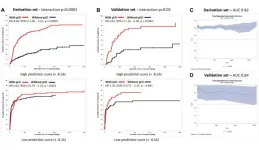(Press-News.org) The vagus nerve, known for its role in ‘resting and digesting’, has now been found to have an important role in exercise, helping the heart pump blood, which delivers oxygen around the body.
Currently, exercise science holds that the ‘fight or flight’ (sympathetic) nervous system is active during exercise, helping the heart beat harder, and the ‘rest and digest’ (parasympathetic) nervous system is lowered or inactive. However, University of Auckland physiology Associate Professor Rohit Ramchandra says that this current understanding is based on indirect estimates and a number of assumptions their new study has proven to be wrong.
“Our study finds the activity in these ‘rest and digest’ vagal nerves actually increases during exercise,” Dr Ramchandra says.
“Our group has used ‘tour de force’ electrical recording techniques to directly monitor vagal nerve activity in exercising sheep and has found the activity in these vagal nerves going to the heart increases during exercise.
”For the heart to sustain a high level of pumping, it needs a greater blood flow during exercise to fuel the increased work it is doing: our data indicate that the increase in vagal activity does just this.”
During exercise, there is a four to five-fold increase in the amount of blood pumped out by the heart per minute. This requires the heart to beat faster and to contract more forcefully.
The heart’s ability to pump blood is modulated by nerves that travel from the brain, called ‘autonomic’ since they work automatically and do not require conscious thought.
These nerves include the ‘fight or flight’ or ‘sympathetic’ nerves and the ‘rest and digest’ vagal nerves, which are termed ‘parasympathetic’.
The vagal nerve connects the brain to the heart, and other internal organs including the gut, regulating the 'rest and digest' parasympathetic nervous system responses.
The new research finds the parasympathetic and sympathetic nervous systems work together in exercise to help the heart pump harder and faster.
The researchers also investigated the role of mediators released by the cardiac vagal nerve.
“The cardiac vagus nerve releases multiple mediators, and previous research has focused on a neurotransmitter, acetylcholine, which has no impact on our ability to exercise,” says Dr Ramchandra.
“Our study focused on a different mediator, vasoactive intestinal peptide (VIP) and it shows that the vagus nerve releases this peptide during exercise, which helps the coronary vessels dilate allowing more blood to pump through the heart.”
The first and co-corresponding author Dr Julia Shanks says, “Vasoactive intestinal peptide was first found in the gut and it does help in digestion, but what we now know is that it is also important in exercise.”
The trial was conducted in sheep, because of their similarity to humans in many important respects including cardiac anatomy and physiology. They are also well-established as an animal model to assist with finding ways to combat heart disease that translate to humans.
These fundamental findings could have applications in diseases, including heart failure, where people cannot tolerate exercise.
“This inability to carry out simple tasks involving exertion means that quality of life is severely compromised in these patients,” Dr Ramchandra says.
“One potential reason why exercise tolerance is reduced is that the diseased heart simply does not receive enough blood.
“Our follow-up study will try to see whether we can use this important role of cardiac vagal nerves to improve exercise tolerance in heart failure.”
There is a lot of interest in trying to ‘hack’ or improve vagal tone as a means to reduce anxiety. Investigating this was outside the scope of the current study.
Dr Ramchandra says we do know that the vagus mediates the slowing down of heart rate and if we have high vagal activity, then our hearts should beat slower.
“Whether this is the same as relaxation, I am not sure, but we can say that regular exercise can improve vagal activity and has beneficial effects.”
See Circulation Research.
Find out about animal-based research at the University of Auckland.
Media contacts
Associate Professor Rohit Ramchandra, Department of Physiology, Faculty of Medical and Health Sciences
M: 022 456 7244
E: r.ramchandra@auckland.ac.nz
FMHS media adviser Jodi Yeats
M: 027 202 6372
E: jodi.yeats@auckland.ac.nz
END
A novel role discovered for vagus nerve
Current ideas about exercise are turned on their head with a new study finding the vagus nerve, famed for helping us ‘rest and digest’, also plays an important role in exercise.
2023-09-27
ELSE PRESS RELEASES FROM THIS DATE:
THE LANCET: Gender inequalities worsen women’s access to cancer prevention, detection and care; experts call for transformative feminist approach
2023-09-27
Peer reviewed / Review, analysis and opinion
Cancer is a leading cause of mortality in women and ranks in the top three causes of premature death (under age 70) in women in almost every country worldwide.
New analysis finds, of the 2.3 million women who die prematurely from cancer each year, 1.5 million lives could be saved through the elimination of exposures to key risk factors or via early detection and diagnosis, while a further 800 000 deaths could be prevented if all women could access optimal ...
Prolonged mismatch between calories eaten and burned may be putting many athletes at risk of REDs (Relative Energy Deficiency in Sport)
2023-09-27
The estimated prevalence of REDs varies by sport, ranging from 15% to 80%. The syndrome often goes unrecognised by athletes themselves, their coaches, and team clinicians, and may unwittingly be exacerbated by the ‘sports culture,’ because of the perceived short term gains on performance from intentionally or unintentionally limiting calorie intake, warns the Statement.
REDs was first recognised as a distinct entity by the IOC in a 2014 consensus statement. This latest consensus, informed by a panel of international experts, draws on key advances in REDs science ...
Government policies work to reduce greenhouse gas emissions
2023-09-27
Policies designed to reduce greenhouse gas emissions have been effective, however more stringent regulations are needed to limit global warming to the Paris temperature goals, finds a new analysis by UCL researchers of international efforts to fight climate change.
The research, published in Annual Reviews of Environment and Resources, tracked the rate of greenhouse gas emissions over the last two decades against global efforts to reduce them. Since the early 2000s, governments around the world have enacted numerous regulations to curb greenhouse gas emissions. Over the same ...
Researchers combat Zika-associated fetal abnormalities using microRNA
2023-09-26
Before SARS-CoV-2 and the COVID-19 pandemic, there was the Zika virus epidemic, lasting from 2015 to 2016. The Zika virus can cause serious birth defects and abnormalities. During the epidemic, one of the most striking results of Zika virus in pregnant women was the increase in offspring with microcephaly or a head much smaller than expected, a condition that can result in abnormal brain development.
While the Zika virus epidemic has ended, future outbreaks are inevitable as most of the world’s population lives in areas where the Zika virus mosquito thrives. Researchers in the Aagaard Lab at Baylor College of Medicine ...
Double trouble: Infamous “eagle killer” bacterium produces not one, but two toxins
2023-09-26
The cyanobacterium Aetokthonos hydrillicola produces not just one, but two highly potent toxins. In the latest issue of the journal Proceedings of the National Academy of Sciences (PNAS), an international team led by Martin Luther University Halle-Wittenberg (MLU) and Freie Universität Berlin describes the second toxin, which had remained elusive until now. Even in low concentrations, it can destroy cells and is similar to substances currently used in cancer treatment. Two years ago, the same team established that the first toxin from the cyanobacterium is the cause of a mysterious disease among bald eagles in the USA.
Aetokthonos hydrillicola is ...
Study finds link to unclean cooking fuels and developmental delays in children
2023-09-26
BUFFALO, N.Y. – Just about everyone knows that cigarette smoke is bad for babies. Should cooking fuels like natural gas, propane and wood be viewed similarly when used indoors?
That’s the takeaway from a new study led by University at Buffalo researchers, who looked at indoor air pollution exposure and early childhood development in a sample of more than 4,000 mother-child pairs in the U.S.
“Exposure to unclean cooking fuel and passive smoke during pregnancy and in early life are associated with developmental delays in ...
Smart carts could detect fire hazards in nuclear facilities
2023-09-26
A University of Texas at Arlington researcher is working with a not-for-profit cooperative to develop and test a smart, automated cart that could replace humans who conduct fire hazard safety checks in nuclear power facilities.
Chan Kan, a UT Arlington assistant professor in the Department of Industrial, Manufacturing and Systems Engineering (IMSE), will lead the $250,000 project with the cooperative Utilities Service Alliance.
“We will develop and build a cart with state-of-the-art equipment that could replace human testing of nuclear facilities,” Kan said.
Currently, when the primary fire-sensing system fails or ...
Understanding of mechanisms behind post-exercise lack of appetite can open new paths to obesity treatment
2023-09-26
The complex relationship between physical activity and energy balance – food intake versus energy expenditure – is still a challenge for science, especially in light of the rising worldwide prevalence of overweight and obesity. Some of the medications available on the market to combat obesity work analogously to hormones associated with appetite control, and for some time researchers have focused on understanding how processes involving metabolites (products of cell metabolism) affect hunger and satiety.
A ...
Living donor liver transplant access is optimal for high-risk waitlisted cirrhosis patients
2023-09-26
“Access to LDLT in a transplant program can optimize the timing of transplant for the increasingly older, frail patient population [...]”
BUFFALO, NY- September 26, 2023 – A new research paper was published in Aging (listed by MEDLINE/PubMed as "Aging (Albany NY)" and "Aging-US" by Web of Science) Volume 15, Issue 17, entitled, “Availability of living donor optimizes timing of liver transplant in high-risk waitlisted cirrhosis patients.”
Liver transplant (LT) candidates have become older and frailer. Growing non-alcoholic steatohepatitis ...
ACC releases guide to home-based cardiac care
2023-09-26
The health care landscape has undergone rapid changes in recent years, requiring clinicians and stakeholders to consider innovative ways to provide care in traditional and non-traditional settings. The American College of Cardiology has released a workbook on home-based cardiac care that provides the cardiovascular care team with tools and resources to incorporate high-quality, patient-centered care in the home setting.
Home-based care is defined as any form of medical care that takes place in the home of the patient; this includes the acceleration of virtual ...
LAST 30 PRESS RELEASES:
Injectable breast ‘implant’ offers alternative to traditional surgeries
Neuroscientists devise formulas to measure multilingualism
New prostate cancer trial seeks to reduce toxicity without sacrificing efficacy
Geometry shapes life
A CRISPR screen reveals many previously unrecognized genes required for brain development and a new neurodevelopmental disorder
Hot flush treatment has anti-breast cancer activity, study finds
Securing AI systems against growing cybersecurity threats
Longest observation of an active solar region
Why nail-biting, procrastination and other self-sabotaging behaviors are rooted in survival instincts
Regional variations in mechanical properties of porcine leptomeninges
Artificial empathy in therapy and healthcare: advancements in interpersonal interaction technologies
Why some brains switch gears more efficiently than others
UVA’s Jundong Li wins ICDM’S 2025 Tao Li Award for data mining, machine learning
UVA’s low-power, high-performance computer power player Mircea Stan earns National Academy of Inventors fellowship
Not playing by the rules: USU researcher explores filamentous algae dynamics in rivers
Do our body clocks influence our risk of dementia?
Anthropologists offer new evidence of bipedalism in long-debated fossil discovery
Safer receipt paper from wood
Dosage-sensitive genes suggest no whole-genome duplications in ancestral angiosperm
First ancient human herpesvirus genomes document their deep history with humans
Why Some Bacteria Survive Antibiotics and How to Stop Them - New study reveals that bacteria can survive antibiotic treatment through two fundamentally different “shutdown modes”
UCLA study links scar healing to dangerous placenta condition
CHANGE-seq-BE finds off-target changes in the genome from base editors
The Journal of Nuclear Medicine Ahead-of-Print Tip Sheet: January 2, 2026
Delayed or absent first dose of measles, mumps, and rubella vaccination
Trends in US preterm birth rates by household income and race and ethnicity
Study identifies potential biomarker linked to progression and brain inflammation in multiple sclerosis
Many mothers in Norway do not show up for postnatal check-ups
Researchers want to find out why quick clay is so unstable
Superradiant spins show teamwork at the quantum scale
[Press-News.org] A novel role discovered for vagus nerveCurrent ideas about exercise are turned on their head with a new study finding the vagus nerve, famed for helping us ‘rest and digest’, also plays an important role in exercise.





